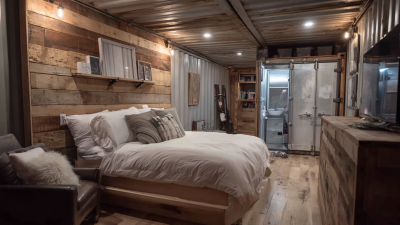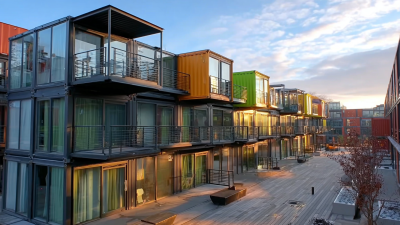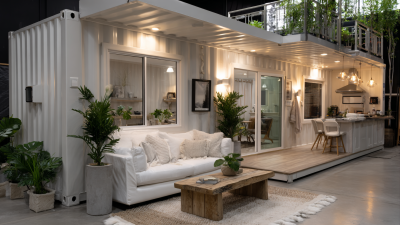Innovative Uses of Shipping Container Buildings Transforming Modern Architecture
The rise of shipping container buildings marks a pivotal shift in modern architecture, combining sustainability with innovative design. According to a 2021 report from McKinsey & Company, the global modular construction market, which includes shipping container structures, is projected to reach $157 billion by 2023, emphasizing the growing acceptance and demand for such solutions.
 Shipping container buildings offer a versatile approach to urban development, enabling faster construction times and reduced waste—essential factors as cities strive to meet environmental goals. A study by the World Economic Forum estimates that constructing with recycled materials, like shipping containers, can lead to a 90% reduction in carbon footprint compared to traditional building methods.
As urbanization accelerates and the need for affordable housing intensifies, innovative uses of shipping container buildings are transforming not just architectural aesthetics, but the entire landscape of urban living.
Shipping container buildings offer a versatile approach to urban development, enabling faster construction times and reduced waste—essential factors as cities strive to meet environmental goals. A study by the World Economic Forum estimates that constructing with recycled materials, like shipping containers, can lead to a 90% reduction in carbon footprint compared to traditional building methods.
As urbanization accelerates and the need for affordable housing intensifies, innovative uses of shipping container buildings are transforming not just architectural aesthetics, but the entire landscape of urban living.
Emerging Trends in Modular Architecture with Shipping Containers
The emergence of shipping container buildings has revolutionized the landscape of modular architecture, offering innovative solutions for sustainable living and urban development. A report by Technavio highlights that the global modular construction market is expected to grow by approximately 6.5% annually through 2025, driven by the rising demand for eco-friendly construction methods. Shipping containers, with their inherent durability and recyclability, perfectly align with contemporary sustainability goals, making them a popular choice for architects and developers alike.
These versatile structures are not just limited to residential homes but are increasingly being integrated into commercial spaces, pop-up shops, and even artistic installations. According to the Modular Building Institute, 85% of the construction industry is undergoing a shift towards modular technology, with shipping container conversions leading this trend. The adaptability of containers allows for unique designs and efficient layouts, making them a practical option in densely populated urban environments where space is at a premium. As we continue to explore the possibilities of container architecture, the blending of functionality and aesthetic appeal is set to lead to new architectural frontiers in modern society.

Key Advantages of Shipping Container Buildings in Urban Development
Shipping container buildings are rapidly gaining popularity in urban development due to their numerous advantages. One of the key benefits is their affordability. Unlike traditional construction materials, shipping containers are often readily available and can be repurposed, significantly reducing costs. This economic efficiency makes them an attractive option for developers looking to create budget-friendly housing or commercial spaces while still maintaining aesthetic appeal.
Another advantage is the speed of construction. Shipping containers come pre-fabricated, allowing for quicker assembly than conventional building methods. This rapid setup not only shortens project timelines but also reduces labor costs. Additionally, the modular nature of container-based designs allows for easily customizable layouts, catering to various needs and preferences. Their durability and sustainability further enhance their appeal, as these structures are able to withstand harsh weather conditions and can be outfitted with energy-efficient systems, promoting environmentally conscious practices in urban planning.
Sustainable Practices: How Shipping Containers Contribute to Green Architecture
Shipping container buildings are increasingly recognized for their significant contribution to sustainable architecture. The reuse of these steel structures not only minimizes waste but also reduces the need for new raw materials. According to a report by the World Economic Forum, using shipping containers as building materials can lead to a reduction in construction costs by over 25%, as well as a notable decrease in carbon emissions. This innovative practice allows architects to construct eco-friendly spaces that blend functionality with sustainability.
Tip: When considering a shipping container project, research local building codes and zoning laws to ensure compliance. Each region may have specific regulations around the adaptation of shipping containers for residential or commercial use.
Additionally, shipping containers are inherently durable and weather-resistant. Their robust nature makes them suitable for various climates and applications, from homes to studios and even public facilities. The International Energy Agency notes that transitioning to such sustainable practices could cut global greenhouse gas emissions by 70% by 2050. By incorporating renewable energy solutions, like solar panels and green roofs, container buildings can further enhance their sustainability profile.
Tip: Explore design options that integrate energy-efficient technologies, such as passive solar heating and low-flow plumbing fixtures, to maximize the sustainability of your container home.

Case Studies: Successful Shipping Container Projects Around the World
Shipping container architecture is rapidly gaining traction around the globe, with various innovative projects demonstrating its potential. One notable case is the "Container City" in London, which uses refurbished shipping containers to create affordable and sustainable living spaces. According to a report by the International Maritime Organization, the use of shipping containers in construction can reduce costs by up to 30% compared to traditional building methods. This method not only provides cost-effective solutions but also significantly minimizes construction waste.
In Australia, the "Recycled Container Home" project showcases how sustainable living can be stylish. The home incorporates energy-efficient designs and utilizes rainwater harvesting systems, pushing the boundaries of eco-friendly architecture. Research from the Global Alliance for Sustainable Housing highlights that container homes can reduce energy consumption by 50%, making them an attractive option for environmentally conscious consumers.
**Tips:** When considering a shipping container project, ensure compliance with local building codes, as regulations may vary significantly by location. Additionally, always factor in insulation and ventilation needs to create a comfortable living environment. Lastly, consider using containers with an appropriate history to avoid potential hazardous materials from previous cargo.
Innovative Uses of Shipping Container Buildings
Economic Impact: Cost-Effective Solutions Offered by Container Architecture
The rising trend of shipping container architecture has not only redefined modern design aesthetics but has also proven to be a cost-effective solution for various construction needs. According to a report by the Container Housing Market Analysis, the average cost of building with shipping containers is significantly lower than traditional structures, often ranging between $110 to $200 per square foot, compared to conventional construction costs that can soar up to $300 per square foot. This economic advantage allows developers and homeowners to maximize their investment while adhering to sustainable practices.
Moreover, container architecture contributes to reduced construction time, which ultimately lowers labor costs. A study by the Urban Land Institute reveals that projects utilizing container buildings can be completed up to 30% faster than traditional constructions. This swift turnaround not only accelerates occupancy and revenue generation but also addresses urgent housing needs in urban areas. As cities face increased demand for affordable housing, shipping container homes offer a viable and economically sound alternative, merging sustainability with practicality in an era where innovative solutions are essential for thriving in the modern architecture landscape.
Innovative Uses of Shipping Container Buildings Transforming Modern Architecture - Economic Impact: Cost-Effective Solutions Offered by Container Architecture
| Project Type | Location | Cost Savings (%) | Construction Time (Months) | Square Footage (Approx.) |
|---|---|---|---|---|
| Healthcare Facilities | USA | 30% | 6 | 3,000 |
| Student Housing | UK | 25% | 4 | 2,500 |
| Retail Spaces | Australia | 40% | 5 | 1,800 |
| Office Spaces | Canada | 35% | 7 | 3,500 |
| Emergency Shelters | Various | 50% | 3 | 1,200 |
Related Posts
-

Innovative Ways to Transform Shipping Container Rooms into Sustainable Living Spaces
-

Discovering the Future of Living: The Rise of Container Condos as Eco-Friendly Housing Solutions
-

How a 40ft Container Cabin Can Transform Your Living Space into an Ecofriendly Haven
-

Innovative Ideas for Shipping Container Remodels You Can Try Today
